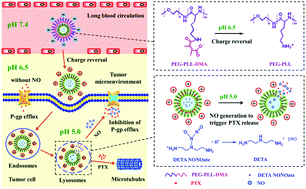A dual pH-sensitive liposomal system with charge-reversal and NO generation for overcoming multidrug resistance in cancer†
Abstract
In cancer therapy, chemotherapeutic drugs frequently encounter multidrug resistance (MDR) induced by the overexpression of drug transporters such as P-glycoprotein (P-gp). Herein, in order to overcome MDR and improve the effectiveness of chemotherapy, we developed a novel pH-sensitive charge-reversal and NO generation liposomal system by modifying a pH-sensitive polymer (PEG-PLL-DMA) on the surface of cationic liposomes for delivering a NO donor (DETA NONOate) and a chemotherapy drug (paclitaxel, PTX) into MDR cells. The proposed liposomal system (PTX/NO/DMA-L) exhibited a distinctive charge-reversal capacity, which was negatively charged under physiological conditions (pH 7.4) but could reverse to positive charge in a tumor microenvironment (pH 6.5) due to the cleavable amide linkages formed between PEG-PLL and DMA, leading to the improvement of cell uptake. Once arrived in the endosomes and lysosomes (pH 5.0), DETA NONOate was triggered to decompose and release NO, which further promoted the quick release of PTX and inhibited the P-gp mediated efflux. The charge-reversal, NO generation and NO-triggered rapid release of drugs could significantly increase the accumulation of PTX in tumors and eventually improve the antitumor efficacy. These results indicate that this dual pH-sensitive liposomal system is a highly promising approach for chemotherapy and may pave a new avenue for overcoming MDR in cancer.



 Please wait while we load your content...
Please wait while we load your content...